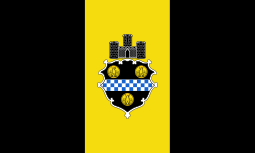Carnegie Museum of Art
The Carnegie Museum of Art, abbreviated CMOA, is an art museum in the Oakland neighborhood of Pittsburgh, Pennsylvania. The museum was founded in 1895 by the Pittsburgh-based industrialist Andrew Carnegie.[1] The museum collects contemporary art, including film and video works. It was the first museum in the United States with a primary focus on contemporary art. As instructed by its founder Andrew Carnegie at the inception of the Carnegie International in 1896, the museum has been organizing many contemporary exhibitions that showcase the "Old Masters of tomorrow".[2]
Exterior view of the Sarah Mellon Scaife Gallery. | |
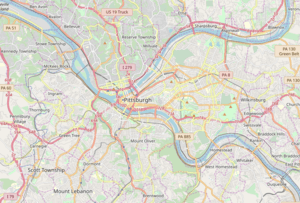 Location of CMMA in Pennsylvania.  Carnegie Museum of Art (Pennsylvania)  Carnegie Museum of Art (the United States) | |
| Former name | Department of Fine Arts, Carnegie Institute |
|---|---|
| Established | November 5, 1895 |
| Location | 4400 Forbes Ave, Pittsburgh, Pennsylvania 15213 |
| Coordinates | 40.443690°N 79.948976°W |
| Type | Art Museum |
| Accreditation | American Alliance of Museums |
| Visitors | 500,000 (2018) |
| Director | Kevin Hiles |
| Curator | Eric Crosby |
| Historian | Ellen Baxter |
| Nearest car park | On site and street |
| Website | cmoa |
History
The museum's origins can be traced to 1886 with Andrew Carnegie's initial concept:[3] "I am thinking of incorporating with the plan for a library that of an art-gallery in which shall be preserved a record of the progress and development of pictorial art in America." Dedicated on November 5, 1895, the art gallery was initially housed in the Carnegie Libraries of Pittsburgh Main Branch in Oakland.
Carnegie envisioned a museum collection consisting of the "Old Masters of tomorrow" and the Carnegie Museum of Art became, arguably, the first museum of modern art in the United States. The museum received a major expansion in 1907 with the addition of the Hall of Architecture, Hall of Sculpture, and Bruce Galleries, with funds again provided by Carnegie.[4]
Under the directorship of Leon Arkus, the Sarah Mellon Scaife Gallery (125,000 square feet) was built as an addition to the existing Carnegie Institute. Designed by architect Edward Larrabee Barnes, it first opened in 1974 and more than doubled the museum's exhibition space, plus added a children's studio, theater, offices, café, and bookstore.[5] The New York Times art critic John Russell described the gallery as an "unflawed paradise." The gallery has been renovated several times since its original creation, most recently in 2004.
Today the museum continues Carnegie's love of contemporary art by staging the Carnegie International every few years. Numerous significant works from the Internationals have been acquired for museum's permanent collection including Winslow Homer's The Wreck (1896) and James A. McNeill Whistler's Arrangement in Black: Portrait of Señor Pablo de Sarasate (1884).
Collections and departments
The museum's curatorial departments include: Fine Arts (Contemporary Art, Works on Paper), Decorative Arts, Architecture, and Photography. The museum presents as many as 15 changing exhibitions annually. Its permanent collection comprises roughly 35,000 works and includes European and American decorative arts from the late seventeenth century to the present, works on paper, paintings, prints (notably Japanese prints), sculptures and installations. The museum has notably strong collections of both aluminum artifacts and chairs. Approximately 1,800 works are on view at any given time.
In 2001, the museum acquired the archive of African-American photographer Charles "Teenie" Harris, consisting of approximately 80,000 photographic negatives spanning from the 1930s to the 1970s. The museum is working with a Teenie Harris Advisory Committee to identify the photographs. Many of these images have been catalogued and digitized and are available online via the Carnegie Museum of Art Collections Search.
Heinz Architectural Center: Established in 1990 with a gift from Mrs. Henry J. Heinz II, the Heinz Architectural Center enhances appreciation and understanding of architecture and the built environment through exhibitions, lectures, charettes, symposia, and other forms of public engagement. Its collection of nearly 6,000 objects includes drawings, models, photographs, artifacts, games, ephemera, and the world's third-largest collection of plaster architectural casts. Ranging from the late 18th century to the present, the collection represents work in architecture, landscape design, engineering, and furniture and interior design by architects of international, national, and regional significance. Areas of strength are residential architecture and leading contemporary British architects; recent collecting activity has focused on the work of emerging practices around the world. In addition to 4,000 square feet of exhibition space, the Heinz Architectural Center's facility, designed by Cicognani Kalla Architects, includes a library housing several thousand books, journals, and other types of printed material.
The Hillman Photography Initiative is an incubator for innovative thinking on the photographic image. The inaugural year of the initiative centered on four projects that, taken together, investigated the boundaries and possibilities of photography through the way that an image travels. Conceived through an open, discursive process, unique in a museum setting, these projects included live public events at the museum, a pop-up reading room in the galleries, two collaborative web-based projects, and a series of commissions, including documentary videos, art projects, and writing.
Collection Themes
- Contemporary Glass
- Teenie Harris Photographs: Erroll Garner and Jazz from the Hill
- Carnegie International
- Japanese Prints
- Pittsburgh Artists
- The Art of the Chair
- Pictorialist Photography
- Painting and Sculpture 1860–1920
- W. Eugene Smith
Galleries
- Ailsa Mellon Bruce Galleries (1907) – originally constructed display reproduction bronze casts from Pompeii and Herculaneum. Renovated in 2009, the galleries exhibit more than 500 objects representing American and European decorative arts from the Rococo and Neoclassical periods of the 18th century to contemporary design and craft.
- Hall of Architecture (1907) – In the late Victorian era, plaster casts of outstanding classical, ancient, and medieval works were mass-produced by various vendors. Just a few museums, like Carnegie Museum of Art, went to extraordinary lengths to develop their own large, unique casts. The West Portal of Saint-Gilles-du-Gard, paid for by Andrew Carnegie on the recommendation of art experts, is one of a kind, and is arguably the largest architectural cast ever made. Today the Hall of Architecture houses almost 140 full-size plaster casts of elements of buildings found in the ancient and classical civilizations of Egypt, Greece and Rome, and from Romanesque, Gothic and Renaissance Europe. As such, it is the largest collection of plaster casts of architectural masterpieces in America and one of the three largest in the world, along with those of the Victoria and Albert Museum in London and the Musée national des Monuments Français in Paris.
- Hall of Sculpture (1907) – modeled upon the Parthenon's inner sanctuary, and originally created to house the museum's 69 plaster casts of Egyptian, Near Eastern, Greek, and Roman sculpture. Today it exhibits works from the permanent collections, with its balcony displaying decorative arts objects from the eighteenth to the twentieth century.
- Heinz Architectural Center (1993) – dedicated to the collection, study, and exhibition of architectural drawings and models.
- Scaife Galleries – Focused primarily on European and American art since 1850, but also including collections of African art, classical and Egyptian art, and older European and American art.
- Works on Paper Gallery
- Forum Gallery – Located on the first floor of the museum just inside the Forbes Avenue entrance, this single room is dedicated to temporary exhibitions of contemporary art. It opened November 3, 1990 with support from the National Endowment of the Arts. The first exhibition, Forum 1, was a solo show of Jeff Wall. Subsequent exhibitions were numbered sequentially (for example, Forum 40 featured Felix de la Concha). Unlike larger museum exhibitions, which can take up to three years to plan and execute, Forum shows come together relatively quickly, and are open to any curatorial staff's vision. In the words of Vicky Clark, a longtime curator at the museum, "The idea was to make sure that we had an exhibition of contemporary art set up at all times."[6]
Programs
Over the past 75 years, more than 100,000 children of all ages have attended Saturday art classes in the galleries of Carnegie Museum of Art. Alumni of the program include Andy Warhol, photographer Duane Michals, and contemporary artist Philip Pearlstein. The museum has an array of programs that are specific to one's age group as well. There are some for children, teens, adults, and there are even some dedicated to school educators.[7] The Carnegie Museum of Art was named 5th most child-friendly art museum in the U.S. by Child magazine.
Adult Program
- Lectures & Talks Lectures and talks are presented by artists, curators, and scholars to enhance visitors' experiences in exploring the exhibitions.
- Film & Music The museum host featured screenings that relate to exhibitions on view or address topics of interest in Pittsburgh and the art world at large. In addition the museum hosts renowned musical artists at the historic Carnegie Music Hall, Oakland.
- Classes & Workshops Engage the museum collection and exhibitions through art history classes and workshops. These classes offer terrific opportunities to investigate individual works or periods in greater depth, and allow visitors to connect with the art currently on view in our galleries.
- Carnegie International Programs
- Third Thursday On the third Thursday of every month, the art galleries of the museum is open late, with music and a late night café menu.
Kids & Family Program
- The Art Connection As Pittsburgh's premier art program for students in grades 5 through 9, The Art Connection is an 18-week that mashes up art appreciation with in-depth studio instruction. The program runs from October to March each year and closes with a student exhibition in the spring.
- Summer Camps Weeklong half- and full-day camps for kids ages 4 through 13, with additional programs available for preschoolers and high school students
Teen Program
- Workshops Workshops provide a chance for high school visitors to look closely at artwork, create public works of art, interact with practicing artists, and experience the museum behind the scenes, with other high schoolers from across the Pittsburgh area.
Educators Program
- Professional Development CMOA organizes professional development opportunities for educators throughout the year.
Community Program
- Storyboard The Carnegie Museum of Art's digital journal, serves as a vital forum for critical engagements with art, culture, and issues relevant to Western Pennsylvania and beyond.
- Recycle Park A partnership between North Braddock residents, the artist collective, the Carnegie Museum of Art, and many others, have supported ongoing revitalization efforts to help bring a second life to a beloved neighborhood park.
- Art Lending Collection at Braddock Carnegie Library Throughout the artworks from participating artists have been made available for checkout to anyone in county with a valid library card in the same way one would check out a book. Braddock Carnegie Library's alternative approach to art lending is changing a community's relationship with art.
- Playful Pittsburgh Collaborative Founded with the goal to educate decision makers to support access to play for people of all ages, the collaborative seeks to engage the broader community through its activities and events. Carnegie Museum of Art, in partnership with the Play Pittsburgh Collaborative looks to incorporate play into our daily lives.
Gallery
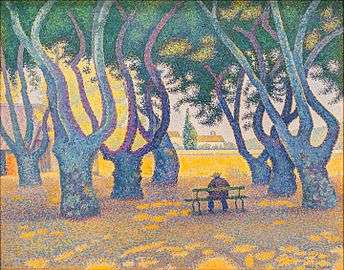 Place des Lices, 1893, oil on canvas, Paul Signac
Place des Lices, 1893, oil on canvas, Paul Signac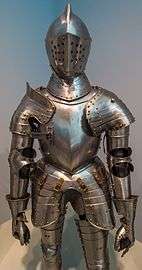 Armor, with Helmet, circa 1555, Anton Peffenhauser
Armor, with Helmet, circa 1555, Anton Peffenhauser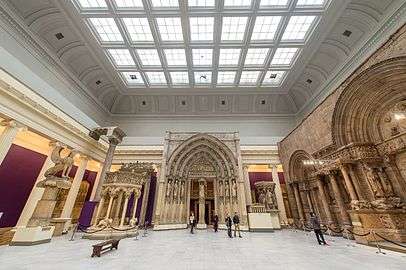 The Hall of Architecture
The Hall of Architecture Ivory portable altar, 14th Century, French
Ivory portable altar, 14th Century, French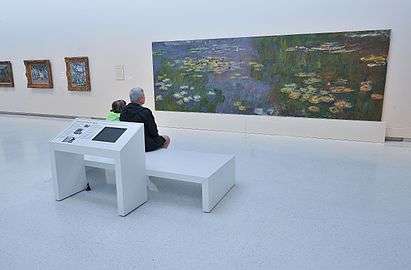 Water Lilies (Nymphéas), 1915–26, oil on canvas, Claude Monet
Water Lilies (Nymphéas), 1915–26, oil on canvas, Claude Monet The 1907 Grand Staircase
The 1907 Grand Staircase Bronze ritualistic vessel, 1300-1150 B.C.E., Shang Dynasty, China
Bronze ritualistic vessel, 1300-1150 B.C.E., Shang Dynasty, China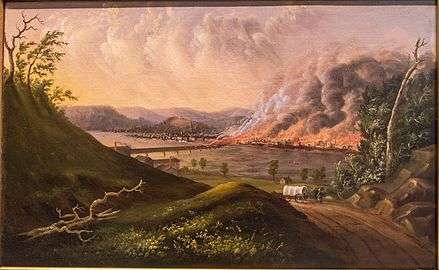 View of the Great Fire of Pittsburgh, 1846, oil on canvas, William Coventry Wall
View of the Great Fire of Pittsburgh, 1846, oil on canvas, William Coventry Wall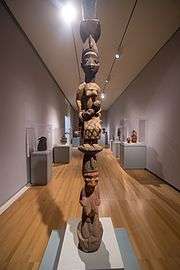 Housepost, circa 1930's, Yoruba Culture, Africa
Housepost, circa 1930's, Yoruba Culture, Africa Ancient Greco-Roman vase
Ancient Greco-Roman vase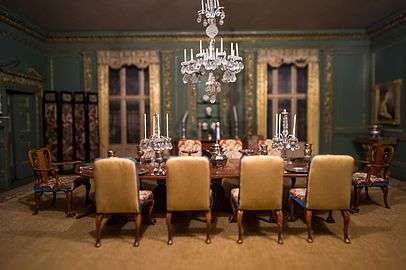 Miniature room on display, Ruth McChesney
Miniature room on display, Ruth McChesney Wheat Fields After the Rain (The Plain of Auvers), 1890, oil on canvas, Vincent Van Gogh
Wheat Fields After the Rain (The Plain of Auvers), 1890, oil on canvas, Vincent Van Gogh Casket for relics of a saint (châsse), 13th Century, French
Casket for relics of a saint (châsse), 13th Century, French Steamboat on the Ohio, 1896, oil on canvas, Thomas Pollock Anshutz
Steamboat on the Ohio, 1896, oil on canvas, Thomas Pollock Anshutz
 Farallon Island, 1887, oil on canvas, Albert Bierstadt
Farallon Island, 1887, oil on canvas, Albert Bierstadt
See also
- Andrew Carnegie
- Carnegie Museums of Pittsburgh
- Homer Saint-Gaudens
- Frick Art & Historical Center
- List of museums in Pennsylvania
- Sally Dixon
References
- About Carnegie Museum of Art: History Archived October 13, 2008, at the Wayback Machine
- Micucci, Dana (2008-05-30). "Carnegie Museum, in Pittsburgh, shows contemporary art's". The New York Times. ISSN 0362-4331. Retrieved 2018-02-07.
- W. J. Holland, LL.D., "The Carnegie Museum", in Popular Science, May 1901.
- Memorial of the celebration of the Carnegie Institute at Pittsburgh, Pa., April 11, 12, 13, 1907.
- Ellen S. Wilson, "The Continuing History of the Scaife Galleries", in Carnegie Online, July/August 2003 "Archived copy". Archived from the original on 2008-09-07. Retrieved 2009-11-29.CS1 maint: archived copy as title (link).
- Pifer, Jenelle (Winter 2015). "The Art of the Now". Carnegie. Carnegie Museum of Art: 24–29.
- "School of Rock, Art, and Science". Carnegie Museums of Pittsburgh.
External links
- Official website
- Carnegie Museums
- A finding aid to the Carnegie Institute, Museum of Art records, 1883-1962, bulk 1885-1940, in the Archives of American Art, Smithsonian Institution
| Wikimedia Commons has media related to Carnegie Museum of Art. |
